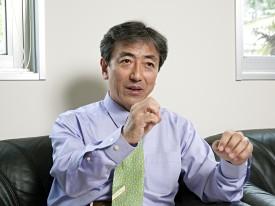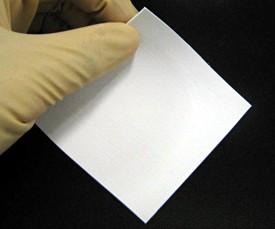

08/30/2010
Many scientists focus their research on making new materials, but tend to lose sight of novelty and the environment. Supercritical fluid technology opens a new world of possibilities in making hybrid materials with multiple functions without relying on hazardous chemicals.
Every fluid has a critical point — a specific combination of temperature and pressure above which the liquid and gas phases disappear and are replaced with a ‘supercritical fluid’ phase.

Supercritical fluids have many unusual properties, such as high density and low viscosity, which make them ideal for use as solvents, as Tadafumi Adschiri — a principal investigator at Tohoku University’s WPI-AIMR and a global leader in supercritical fluids — points out. “We can tune the density of a supercritical fluid through small changes in temperature or pressure,” he says. “Because solubility and phase behavior are a direct function of density, we could mix a supercritical fluid, such as water, with many things that are normally immiscible or insoluble, such as oil or hydrogen gas.”
Adschiri has been using supercritical fluids for the synthesis of inorganic nanocrystals, which have a vast number of potential uses in industry but which are usually prepared using harsh chemicals. So far he has made nanocrystals of various metal oxides, including titanium dioxide, zirconium oxide and selenium oxide, as well as double-metal oxides such as barium titanate and barium ferrite. “There are many methods for synthesizing nanocrystals, but there are several problems. One problem is the use of organic solvents, which are hazardous to the environment. Another problem is low productivity.”
Adschiri has been able to increase the productivity of synthesis by growing the nanocrystals in supercritical water, avoiding the use of hazardous chemicals. Furthermore, as supercritical water mixes with oil, Adschiri can synthesize novel organic–inorganic hybrid nanocrystals — a feat that could not be achieved using conventional methods.

“Many people can make inorganic nanocrystals, but they have difficulty dispersing these nanocrystals in polymers or organic solvents. We can make nanocrystals with organic molecules on the surface, which have high affinity with plastic polymers and organic solvents, and then transplant them into polymer films. We can also tune the properties of the polymers very easily.”
Using his unique nanocrystals, Adschiri is developing a range of nanocrystal–polymer hybrids, including a transparent film with high refractive index. The plastic film rolls up just like any normal plastic film, but its high refractive index could be useful for manufacturing thinner optical lens and anti-reflective coatings. “You cannot see the particles, but they give the film a very high refractive index,” says Adschiri.
Another hybrid film he is developing is a plastic film consisting of over 90% boron nitride particles. The hybrid material has high thermal conductivity but low electrical conductivity — normally incompatible properties — and can be used as a heat-transfer material for cellular phones, computers and other electronic devices. In collaboration with other WPI-AIMR researchers, Adschiri is also working on a plastic film containing magnetic particles, which he believes could be useful for making polarizers and photonic tuners. “We call these novel hybrid materials ‘super hybrid materials’ because they have multiple, normally incompatible properties,” he says.

Image courtesy of Denki Kagaku Kogyo Co.
Adschiri opened his laboratory eight years ago, and at that time, he already foresaw the importance of working with researchers from completely different fields. “I was working in the field of supercritical fluids, but to explore new materials, I needed people who had different viewpoints. I had three positions in the laboratory, so I invited a biochemist, a material scientist and a computer scientist to join,” he says.
In the beginning, the four original members of the team did not have a common scientific background. But they spent half a year explaining their ideas to each other from a basic graduate level and eventually found a direction they all could follow — the combination of nanoparticles, polymers and biomaterials, brought together with simulations of the underlying physics.
Adschiri now has 30 researchers, including ten postdoctoral researchers, working in his laboratory. His unique philosophy of fusing different expertise and ideas is still evident in the people he employs, and he remains undaunted by any perceived risk of working with people with such diverse backgrounds: “It’s a gamble, but I like a gamble,” he says.
Many companies are now interested in using organic and inorganic materials to make super hybrid materials. Looking forward, Adschiri has a clear vision for where he wants to take his group’s research on super hybrid materials: He intends to support the growth of this unique technology while exploring the creation of new materials through the fusion of ideas.